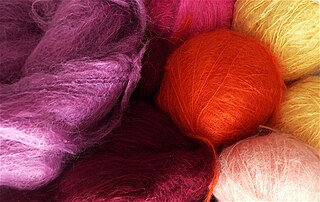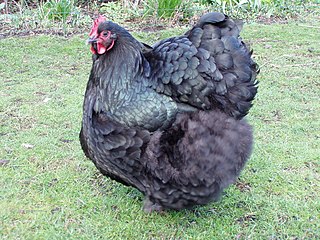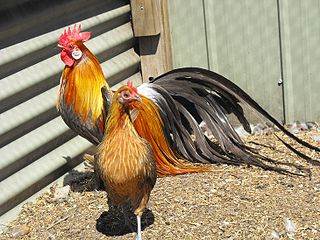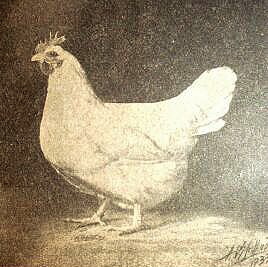
The Angora goat is a breed of domesticated goat, historically known as Angora. Angora goats produce the lustrous fibre known as mohair.

Mohair is a fabric or yarn made from the hair of the Angora goat. Both durable and resilient, mohair is notable for its high luster and sheen, and is often used in fiber blends to add these qualities to a textile. Mohair takes dye exceptionally well. It feels warm in winter as it has excellent insulating properties, while its moisture-wicking properties allow it to remain cool in summer. It is durable, naturally elastic, flame-resistant and crease-resistant. It is considered a luxury fiber, like cashmere, angora, and silk, and can be more expensive than most sheep's wool.

Angora hair or Angora fibre refers to the downy coat produced by the Angora rabbit. While the names of the source animals are similar, Angora fibre is distinct from mohair, which comes from the Angora goat. Angora fibre is also distinct from cashmere, which comes from the cashmere goat. Angora is known for its softness, thin fibres, and what knitters refer to as a halo (fluffiness). It is also known for its silky texture. It is much warmer and lighter than wool due to the hollow core of the angora fibre. It also gives them their characteristic floating feel.

The Angora rabbit, which is one of the oldest types of domestic rabbit, is bred for the long fibers of its coat, known as Angora wool, which are gathered by shearing, combing or plucking. Because rabbits do not possess the same allergy-causing qualities as many other animals, their wool is an important alternative. There are at least 11 distinct breeds of Angora rabbit, four of which are currently recognized by the American Rabbit Breeders Association (ARBA): English Angora, French Angora, Giant Angora and Satin Angora. Others include German Angora, Chinese Angora, Finnish Angora, Japanese Angora, Korean Angora, Russian Angora, St Lucian Angora and Swiss Angora.

The Orpington is a British breed of chicken. It was bred in the late nineteenth century by William Cook of Orpington, Kent in south-east England. It was intended to be a dual-purpose breed, to be reared both for eggs and for meat, but soon became exclusively a show bird.

The Nigerian Dwarf is an American breed of dwarf goat. Like the American Pygmy Goat, it derives from the West African Dwarf group of breeds of West Africa.

The Pekin or White Pekin is an American breed of domestic duck, raised primarily for meat. It is a mallard derived from birds brought to the United States from China in the nineteenth century, and is now bred in many parts of the world. It is often known as the American Pekin to distinguish it from the German Pekin, a distinct and separate breed which derives from the same Chinese stock but has different breeding. Many of these ducks were reared on Long Island, New York, in the late nineteenth and early twentieth centuries, from which the breed derived its name Long Island Duck.

A cashmere goat is a type of goat that produces cashmere wool, the goat's fine, soft, downy, winter undercoat, in commercial quality and quantity. This undercoat grows as the day length shortens and is associated with an outer coat of coarse hair, which is present all the year and is called guard hair. Most common goat breeds, including dairy goats, grow this two-coated fleece.

The Pygora goat is a breed of goat that originated from crossing the registered NPGA Pygmy goat and the white AAGBA Angora goat. Pygoras, along with the Angora goat and Cashmere goat, are fiber goats. Pygora goats produce three distinct kinds of fleece.

The Orenburg shawl is a Russian knitted lace textile using goat down and stands as one of the classic symbols of Russian handicraft, along with Tula samovars, the Matrioshka doll, Khokhloma painting, Gzhel ceramics, the Palekh miniature, Vologda lace, Dymkovo toys, Rostov finift (enamel), and Ural malachite.

The Australian Cashmere goat is a breed of Cashmere domestic goats originating in Australia. Whilst retaining the fertility and hardiness of the bush goat, the Australian Cashmere is quite different in appearance and temperament. In midwinter, it has an excellent overall coverage of long, dense cashmere.

The Phoenix is a German breed of long-tailed chicken. It derives from cross-breeding of imported long-tailed Japanese birds similar to the Onagadori with other breeds.

Animal fibers are natural fibers that consist largely of certain proteins. Examples include silk, hair/fur and feathers. The animal fibers used most commonly both in the manufacturing world as well as by the hand spinners are wool from domestic sheep and silk. Also very popular are alpaca fiber and mohair from Angora goats. Unusual fibers such as Angora wool from rabbits and Chiengora from dogs also exist, but are rarely used for mass production.
The California Red is a breed of domestic sheep developed in the United States.

The Lamona is an American breed of chicken. It was developed from 1912 by Harry S. Lamon, who was the senior poultry expert of the Bureau of Animal Industry, at the Beltsville Agricultural Research Center of the U.S. Department of Agriculture in Beltsville, Maryland.

The domestic goat or simply goat is a subspecies of C. aegagrus domesticated from the wild goat of Southwest Asia and Eastern Europe. The goat is a member of the animal family Bovidae and the subfamily Caprinae, meaning it is closely related to the sheep. There are over 300 distinct breeds of goat. It is one of the oldest domesticated species of animal, according to archaeological evidence that its earliest domestication occurred in Iran at 10,000 calibrated calendar years ago.

The American Bantam Association is a poultry fancy association for breeders of bantam poultry. It publishes the Bantam Standard, with detailed descriptions of all the bantam breeds and varieties that it recognizes; in most – but not all – cases, these are the same as those recognised by the American Poultry Association. It also publishes a quarterly magazine and annual yearbook, hosts poultry shows and provides judges for them, and provides information on bantam breeds.
The American Dairy Goat Association or ADGA is a United States not-for-profit corporation dedicated to dairy goats. Its purpose is to promote the dairy goat industry, by providing and circulating sound information about goats and goats' milk; maintaining and publishing herd books and production records of milk goats; and issuing certificates of registration and recordation; improving and developing the milk goat breeds; and providing publicity and service for the goat dairying industry. The principal operation of the corporation is in Columbia, Missouri, and its headquarters are in Spindale, North Carolina.

Goat farming involves the raising and breeding of domestic goats as a branch of animal husbandry. People farm goats principally for their meat, milk, fibre and skins.

















